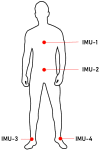A Systematic Evaluation of Feature Encoding Techniques for Gait Analysis Using Multimodal Sensory Data
- PMID: 38202937
- PMCID: PMC10780594
- DOI: 10.3390/s24010075
A Systematic Evaluation of Feature Encoding Techniques for Gait Analysis Using Multimodal Sensory Data
Abstract
This paper addresses the problem of feature encoding for gait analysis using multimodal time series sensory data. In recent years, the dramatic increase in the use of numerous sensors, e.g., inertial measurement unit (IMU), in our daily wearable devices has gained the interest of the research community to collect kinematic and kinetic data to analyze the gait. The most crucial step for gait analysis is to find the set of appropriate features from continuous time series data to accurately represent human locomotion. This paper presents a systematic assessment of numerous feature extraction techniques. In particular, three different feature encoding techniques are presented to encode multimodal time series sensory data. In the first technique, we utilized eighteen different handcrafted features which are extracted directly from the raw sensory data. The second technique follows the Bag-of-Visual-Words model; the raw sensory data are encoded using a pre-computed codebook and a locality-constrained linear encoding (LLC)-based feature encoding technique. We evaluated two different machine learning algorithms to assess the effectiveness of the proposed features in the encoding of raw sensory data. In the third feature encoding technique, we proposed two end-to-end deep learning models to automatically extract the features from raw sensory data. A thorough experimental evaluation is conducted on four large sensory datasets and their outcomes are compared. A comparison of the recognition results with current state-of-the-art methods demonstrates the computational efficiency and high efficacy of the proposed feature encoding method. The robustness of the proposed feature encoding technique is also evaluated to recognize human daily activities. Additionally, this paper also presents a new dataset consisting of the gait patterns of 42 individuals, gathered using IMU sensors.
Keywords: classification; feature encoding; gait analysis; human activity recognition; time series sensory data.
Conflict of interest statement
The authors declare no conflicts of interest.
Figures








Similar articles
-
A Comparative Study of Feature Selection Approaches for Human Activity Recognition Using Multimodal Sensory Data.Sensors (Basel). 2021 Mar 29;21(7):2368. doi: 10.3390/s21072368. Sensors (Basel). 2021. PMID: 33805368 Free PMC article.
-
A Machine Learning Pipeline for Gait Analysis in a Semi Free-Living Environment.Sensors (Basel). 2023 Apr 14;23(8):4000. doi: 10.3390/s23084000. Sensors (Basel). 2023. PMID: 37112339 Free PMC article.
-
Human Gait Activity Recognition Using Multimodal Sensors.Int J Neural Syst. 2023 Nov;33(11):2350058. doi: 10.1142/S0129065723500582. Epub 2023 Sep 30. Int J Neural Syst. 2023. PMID: 37779221
-
Inertial Sensor Technologies-Their Role in Equine Gait Analysis, a Review.Sensors (Basel). 2023 Jul 11;23(14):6301. doi: 10.3390/s23146301. Sensors (Basel). 2023. PMID: 37514599 Free PMC article. Review.
-
A Systematic Review of Gait Analysis in the Context of Multimodal Sensing Fusion and AI.IEEE Trans Neural Syst Rehabil Eng. 2023;31:4189-4202. doi: 10.1109/TNSRE.2023.3325215. Epub 2023 Oct 26. IEEE Trans Neural Syst Rehabil Eng. 2023. PMID: 37847624
Cited by
-
Optimizing Fall Risk Diagnosis in Older Adults Using a Bayesian Classifier and Simulated Annealing.Bioengineering (Basel). 2024 Sep 11;11(9):908. doi: 10.3390/bioengineering11090908. Bioengineering (Basel). 2024. PMID: 39329650 Free PMC article.
References
-
- Whittle M.W. The Soft Tissues. Elsevier; Amsterdam, The Netherlands: 1993. Gait analysis; pp. 187–199.
-
- Ghent F., Mobbs R.J., Mobbs R.R., Sy L., Betteridge C., Choy W.J. Assessment and post-intervention recovery after surgery for lumbar disk herniation based on objective gait metrics from wearable devices using the gait posture index. World Neurosurg. 2020;142:e111–e116. doi: 10.1016/j.wneu.2020.06.104. - DOI - PubMed
-
- Khan M.H., Farid M.S., Grzegorzek M. Vision-based approaches towards person identification using gait. Comput. Sci. Rev. 2023;42:100432. doi: 10.1016/j.cosrev.2021.100432. - DOI
-
- Khan M.H., Farid M.S., Grzegorzek M. Spatiotemporal features of human motion for gait recognition. Signal Image Video Process. 2019;13:369–377. doi: 10.1007/s11760-018-1365-y. - DOI
MeSH terms
Grants and funding
LinkOut - more resources
Full Text Sources

